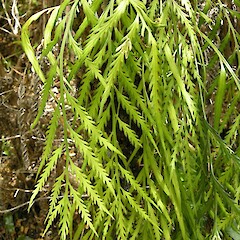Asplenium flaccidum
Common name
drooping spleenwort, hanging spleenwort
Synonyms
Darea odontites (Thunb.) Willd.; Asplenium bulbiferum var. flaccidum (G.Forst.) Domin; Asplenium marinum var. flaccida (G.Forst.) F.Muell.; Caenopteris novae-zeelandiae Spreng.; Caenopteris odontites Thunb.; Darea flaccida (G.Forst.) Willd.; Asplenium heterophyllum A.Rich.; Asplenium odontites (Thunb.) R.Br.; Caenopteris flaccida (G.Forst.) Thunb.
Family
Aspleniaceae
Flora category
Vascular – Native
Endemic taxon
No
Endemic genus
No
Endemic family
No
Structural class
Ferns
NVS code
The National Vegetation Survey (NVS) Databank is a physical archive and electronic databank containing records of over 94,000 vegetation survey plots - including data from over 19,000 permanent plots. NVS maintains a standard set of species code abbreviations that correspond to standard scientific plant names from the Ngä Tipu o Aotearoa - New Zealand Plants database.
ASPFLA
Chromosome number
2n = 144
Current conservation status
The conservation status of all known New Zealand vascular plant taxa at the rank of species and below were reassessed in 2017 using the New Zealand Threat Classification System (NZTCS) – more information about this can be found on the NZTCS website. This report includes a statistical summary and brief notes on changes since 2012 and replaces all previous NZTCS lists for vascular plants.
Please note, threat classifications are often suggested by authors when publications fall between NZTCS assessment periods – an interim threat classification status has not been assessed by the NZTCS panel.
- Conservation status of New Zealand indigenous vascular plants, 2017 . 2018. Peter J. de Lange, Jeremy R. Rolfe, John W. Barkla, Shannel P. Courtney, Paul D. Champion, Leon R. Perrie, Sarah M. Beadel, Kerry A. Ford, Ilse Breitwieser, Ines Schönberger, Rowan Hindmarsh-Walls, Peter B. Heenan and Kate Ladley. Department of Conservation. Source: NZTCS and licensed by DOC for reuse under the Creative Commons Attribution 4.0 International licence.
2017 | Not Threatened | Qualifiers: SO
Previous conservation statuses
2012 | Not Threatened
2009 | Not Threatened
2004 | Not Threatened
Distribution
Indigenous. Kermadec Islands, Manawatāwhi / Three Kings Islands, North Island, South Island, Stewart Island/Rakiura, Chatham Islands, Snares Islands/Tini Heke. Also present in Australia and the wider Pacific.
Habitat
Coastal to montane (at the tree limit). In tall forest, scrub or rough boulder strewn ground. Mostly epiphytic on various native trees but also found on the ground.
Wetland plant indicator status rating
Information derived from the revised national wetland plant list prepared to assist councils in delineating and monitoring wetlands (Clarkson et al., 2021 Manaaki Whenua – Landcare Research Contract Report LC3975 for Hawke’s Bay Regional Council). The national plant list categorises plants by the extent to which they are found in wetlands and not ‘drylands’. The indicator status ratings are OBL (obligate wetland), FACW (facultative wetland), FAC (facultative), FACU (facultative upland), and UPL (obligate upland). If you have suggestions for the Wetland Indicator Status Rating, please contact: [Enable JavaScript to view protected content]
UPL: Obligate Upland
Rarely is a hydrophyte, almost always in uplands (non-wetlands).
Detailed description
Mostly epiphytic. Rhizome short, stout, erect, bearing dark brown subulate scales up to 20 × 2 mm. Stipes 50–200 mm (or more) long, brown on underside, green above, flaccid, sparingly covered in small subulate scales with long filiform apices. Laminae lanceolate to elliptic, 150–900 (or more) × 50–250 mm, dull green, thick, leathery, limp and pendulous, pinnate to bipinnate. Raches green, sparingly scaly. Pinnae in 5–20 (or more) pairs, linear, acuminate, long stalked, 50–150 × 5–20 mm; degree of dissection very variable, sometimes only divided into very short obtuse segments, sometimes pinnate. Pinnules very variable in length, from oblong and obtuse to linear and acute, up to 15 × 2 mm. Basal acroscopic pinnule occasionally much longer than that next to it. Sori submarginal, linear, 2–10 mm long. Spores (31)–36–44–(50) × (19)–23–27–(33) μm.
Similar taxa
Allied to Asplenium haurakiense (Brownsey) Ogle from which it differs by its mostly epiphytic growth habit, wider ecological range (from exposed coastal areas through forest to the tree line), tetraploid (2n = 144) rather than octoploid (2n = 288) chromosome number, subulate rhizome and stipe scales (with long filiform apices and thin cell walls); pendulous rather than stiffly erect, dull green rather than usually glossy green, lanceolate to elliptic fronds; by the basal acroscopic pinnule which is only occasionally much longer than that next to it, and rarely pinnatifid; and by the smaller spores. Asplenium appendiculatum (Labill.) C.Presl subsp. appendiculatum occupies similar habitats and is somewhat similar. It can be distinguished from A. flaccidum by its usually terrestrial growth habit, octoploid (2n = 288) rather than tetraploid (2n = 144) chromosome number, and by having a more or less erect frond and a larger spore size.
Life cycle
Minute spores are wind dispersed (Thorsen et al., 2009).
Propagation technique
Easily grown. An excellent pot and hanging basket fern. Can be slow establish. Prefers semi-shade, and should be planted in a fertile, free draining soil.
Etymology
asplenium: From the Greek a- ‘without’ and splene ‘spleen’, a northern hemisphere species, the black spleenwort (Asplenium adiantum-nigrum), was once believed to be a cure for diseases of the spleen.
flaccidum: Weak or limp; from the Latin flaccidus; habit of the leaves
Notes on taxonomy
Kermadec Island plants are potentially distinct and seem closer to A. haurakiense. Further research into their status is needed.
Attribution
Description modified from Brownsey (1977)
References and further reading
Brownsey PJ. 1977. A taxonomic revision of the New Zealand species of Asplenium. New Zealand Journal of Botany 15(1): 39–86. https://doi.org/10.1080/0028825X.1977.10429618.
Thorsen MJ, Dickinson KJM, Seddon PJ. 2009. Seed dispersal systems in the New Zealand flora. Perspectives in Plant Ecology, Evolution and Systematics 11: 285–309. https://doi.org/10.1016/j.ppees.2009.06.001.








